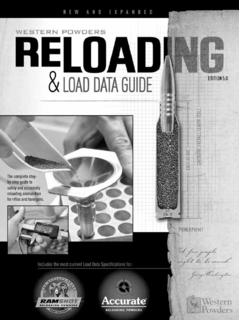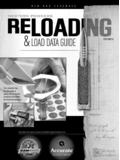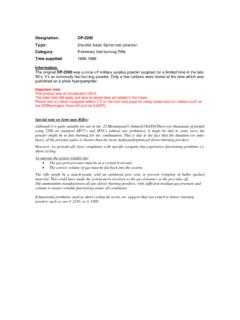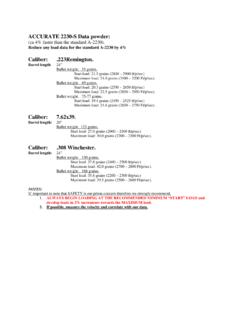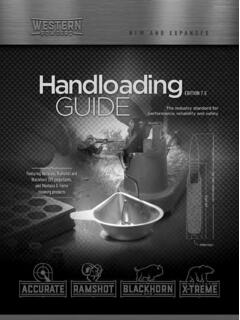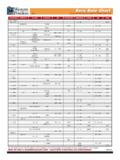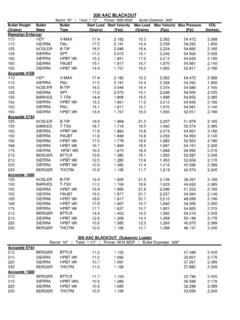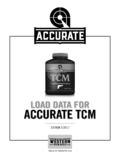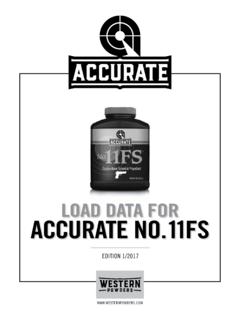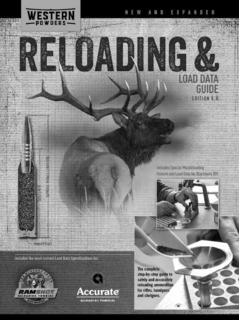Transcription of WESTERN POWDERS, INC - Accurate Powder
1 Single-Base Gun Powder WESTERN Powders, Inc. Issue Date: 11/05/2015. Safety Data Sheet according to OSHA HazCom Standard (2012) requirements Section 1 - Identification of the Mixture and of the Company Product Names: Accurate Solo 1000, Accurate LT-30, Accurate LT-32, Accurate 2015, Accurate 2495, Accurate 4064, Accurate 4350. Trade Names and Synonyms: Extruded gunpowder, Single-base gunpowder. Relevant Identified Uses: Product is intended for use in smokeless propellant applications only. Distributed By: WESTERN POWDERS, INC. Box 158. Miles City, Montana 59301. Telephone: (406)234-0422. Fax: (406)234-0430. Website Email: Emergencies Chemtrec 1-800-424-9300.
2 Section 2 - HAZARD IDENTIFICATION. Classification of the Mixture: Explosives Division GHS Classification: Signal Word: Danger Hazard Statements: H203 Explosive; fire, blast or projection hazard. H302 Harmful if swallowed. H319 Causes serious eye irritation. H317 May cause an allergic skin reaction. H371 May cause damage to organs (circulatory system, blood, kidneys, liver) through prolonged or repeated exposure. Precautionary Statements Prevention P210 Keep away from heat. P240 Ground or bond container and receiving equipment P250 Do not subject to shock or friction. P260 Do not breathe dust. P280 Wash thoroughly after handling.
3 P270 Do not eat, drink or smoke when using this product. P281 Wear protective gloves, protective clothing and eye protection. Response P370 Explosion risk. In case of fire: Evacuate area. Use water to extinguish. Do NOT. fight fire when fire reaches explosives. P312 If swallowed: Call a poison control center or doctor if you feel unwell. P330 Rinse mouth. P305 If in eyes: Rinse cautiously with water for several minutes. P338 Remove contact lenses, if present and easy to do. Continue rinsing. P303 If on skin: Wash with plenty of water. P337 If eye irritation persists: Call a doctor. P333 If skin rash persists: Call a doctor.
4 P363 Wash contaminated clothing before reuse. Storage P410+412 Store in a well-ventilated place away from direct sunlight. P404 Keep container tightly closed. P420 Store away from ignition sources. Disposal P501 Store and dispose of container, waste and residues in accordance with all applicable legal and regulatory requirements. Section 3 - COMPOSITION / INFORMATION ON INGREDIENTS. Substances: Product is a mixture. CAS Number %[Weight] Name 9004-70-0 50-100 Nitrocellulose 84-74-2 0-10 Dibutyl Phthalate Not Available 0-10 Polyester Adipate 85-98-3 0-10 Ethyl Centralite (diethyldiphenylurea). 8050-09-07 0-5 Rosin 13114-72-2 0-3 Akardite II.
5 7757-79-1 0-3 Potassium Nitrate 7778-80-5 0-3 Potassium Sulfate 141-78-6 0-2 Ethyl Acetate 141-78-6 Diphenylamine 86-30-6 N-Nitrosodiphenylamine 18282-10-5 Tin Dioxide 1317-65-3 0-1 Calcium Carbonate 7782-42-5 0-1 Graphite Section 4 - FIRST AID MEASURES. Inhalation Remove to fresh air. If not breathing, institute rescue breathing. If breathing is difficult, ensure airway is clear, give oxygen and continue to monitor. If heart has stopped, immediately begin cardiopulmonary resuscitation (CPR). Keep affected person warm and at rest. Get immediate medical attention. Eye Contact Do not rub eyes. Immediately flush with plenty of water for up to 15 minutes.
6 Remove any contact lenses and open eyelids wide apart. If eye irritation develops, call a physician. Skin Contact Immediately wash exposed skin with plenty of soap and water while removing contaminated clothing and shoes. May be absorbed through the skin in harmful amounts. Call a physician if you feel unwell. Wash clothing before re-use. If clothing is to be laundered, inform the person performing the operation of the contaminants hazardous properties. Ingestion Rinse mouth thoroughly with water and give large amounts water to people not unconscious. Do NOT induce vomiting. Get immediate medical attention. Do not give anything by mouth if the person is unconscious or if having convulsions.
7 Most important symptoms and effects, both acute and delayed. Eye irritation. Symptoms may include itching, burning, redness and tearing. Skin contact may cause redness and pain. Ingestion may cause gastrointestinal irritation, nausea, vomiting and diarrhea. High concentrations of dust may irritate throat and respiratory system and cause coughing. Indications of any immediate medical attention and special treatment needed. Provide general supportive measures and treat symptomatically. Keep victim under observation. Section 5 - FIRE FIGHTING MEASURES. EXTINGUISHING MEDIA: Large volumes of water should be applied as quickly as possible from automatic sprinklers or fire hose.
8 Unsuitable extinguishing media Do not use water jet as an extinguisher, as this may spread fire. Special Hazards arising from the substrate or mixture. Toxic vapors/gases may be formed during a fire. Combustion products vary depending on fire conditions and other combustibles present. The predominant products will be carbon dioxide and oxides of nitrogen, Under some conditions, methane, carbon monoxide, irritating aldehydes and carboxylic acids, and hydrogen cyanide may be formed. Special protective equipment and precautions for firefighters Self-contained breathing apparatus (SCBA) and full protective clothing must be worn in case of fire.
9 This includes, but is not limited to, impervious boots, gloves, hard hat and chemically impermeable suit. Fire-fighting equipment/instructions Fires involving smokeless propellant should NOT be fought unless extinguishing media can be applied from a well protected ( behind a berm or barricade) and distant location from the point of fire. Specific methods Evacuate personnel to a safe area according to pre-determined evacuation plan. Use standard firefighting procedures and consider the hazards of other involved materials. General fire hazards Explosive; fire, blast or projection hazard. Section 6 - ACCIDENTAL RELEASE MEASURES.
10 Personal precautions, protective equipment and emergency procedures. Keep unnecessary personnel away. Eliminate all ignition sources. Use only non-sparking tools. Wear appropriate protective equipment and non-flammable or flame retardant clothing during clean-up. Avoid inhalation of dust. Use a NIOSH/MSHA approved respirator if there is a risk of exposure to dust/fumes at levels exceeding the exposure limits. Do not touch damaged containers or spilled material unless wearing appropriate protective clothing. Ensure adequate ventilation. Local authorities should be advised if significant spillages cannot be contained.
